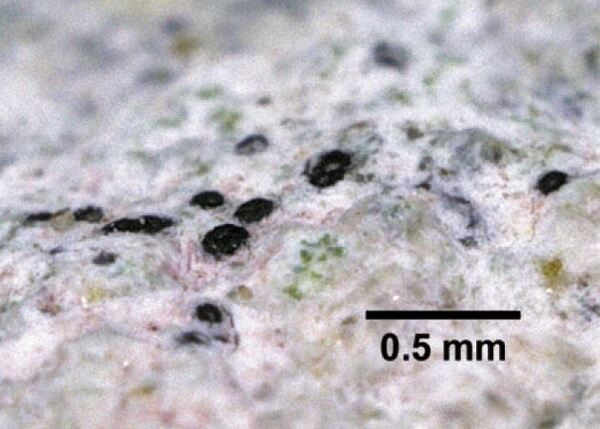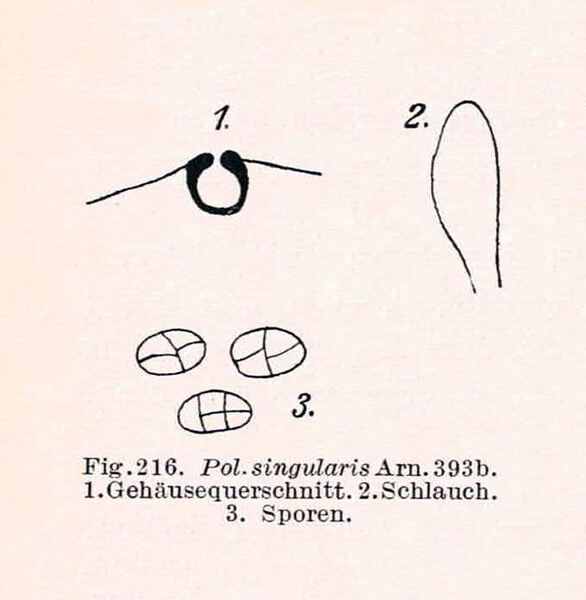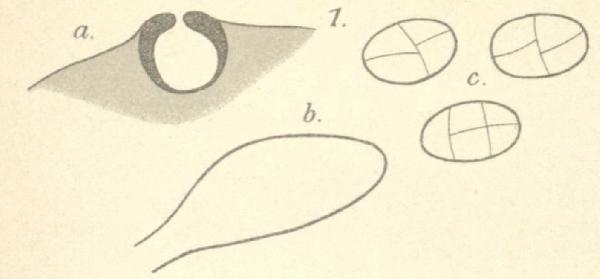Polyblastia singularis (Kremp.) Arnold
Verh. zool.-bot. Ges. Wien, 18: 949, 1868.. Basionym: Verrucaria singularis Kremp. - Denkschr. kgl. bayer. bot. Ges., Abt. 2, 4: 291, 1861.
Synonyms:
Distribution: N - TAA (Dalla Torre & Sarnthein 1902, Nascimbene & al. 2022, Breuss 2024).
Description: Thallus crustose, thinly episubstratic, continuous to usually rimose, whitish, pale grey-brown or ochraceous, sometimes poorly evident, rarely delimited by a black prothallus. Hyphae of the algal layer not oriented vertically. Perithecia black, 0.13-0.18 mm across, numerous, almost fully immersed in the thallus, the visible part slightly flattened, with a depressed ostiole. Involucrellum well-developed, limited to the upper half of the perithecium, clearly distinct from exciple except in the ostiolar region; exciple pseudoparenchymatous, pale brown throughout, merged with the involucrellum in the uppermost part; hamathecium of periphyses and periphysoids, interascal filaments absent; periphysoids 16-23 μm long and 1.5-2 μm thick, sparingly branched in the uppermost part; hymenial gel I+ red, K/I+ blue. Asci 8-spored, clavate, K/I-, fissitunicate, the wall thickened above, with a broad ocular chamber, dehiscent by extrusion of an endotunica to form a delicate rostrum. Ascospores submuriform, with 1-2 oblique tranverse septa and 1 longitudinal septum arranged crosswide, 4-6(-8)-celled in optical view, hyaline, subglobose, 9-12(-14) x 7-8(-10) μm. Photobiont chlorococcoid. Spot tests: K-, C-, KC-, P-, UV-. Chemistry: without lichen substances.
Note: on dolomite and limestone near and above treeline; not always distinguished from P. plicata, with several scattered records in Central Europe; to be looked for further in the Italian Alps.
Growth form: Crustose endolithic
Substrata: rocks
Photobiont: green algae other than Trentepohlia
Reproductive strategy: mainly sexual
Commonnes-rarity: (info)
Alpine belt: very rare
Subalpine belt: very rare
Oromediterranean belt: absent
Montane belt: absent
Submediterranean belt: absent
Padanian area: absent
Humid submediterranean belt: absent
Humid mediterranean belt: absent
Dry mediterranean belt: absent

Predictive model

Source: Sanja Savic & Leif Tibell. 2012. Polyblastia in Northern Europe and the adjacent Arctic. Symb. Bot. Upsal. 36,1.
Growth form: Crustose endolithic
Substrata: rocks
Photobiont: green algae other than Trentepohlia
Reproductive strategy: mainly sexual
Commonnes-rarity: (info)
Alpine belt: very rare
Subalpine belt: very rare
Oromediterranean belt: absent
Montane belt: absent
Submediterranean belt: absent
Padanian area: absent
Humid submediterranean belt: absent
Humid mediterranean belt: absent
Dry mediterranean belt: absent

Predictive model

 INDEX FUNGORUM
INDEX FUNGORUM
 GBIF
GBIF
 DOLICHENS
DOLICHENS



